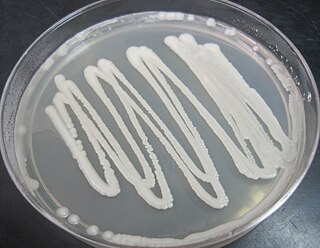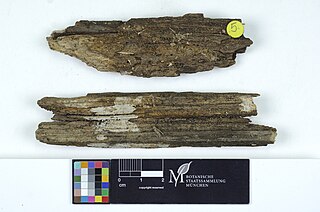
The Ustilaginomycotina is a subdivision within the division Basidiomycota of the kingdom Fungi. It consists of the classes Ustilaginomycetes and Exobasidiomycetes, and in 2014 the subdivision was reclassified and the two additional classes Malasseziomycetes and Monilielliomycetes added. The name was first published by Doweld in 2001; Bauer and colleagues later published it in 2006 as an isonym. Ustilagomycotina and Agaricomycotina are considered to be sister groups, and they are in turn sister groups to the subdivision Pucciniomycotina.

Pucciniomycotina is a subdivision of fungus within the division Basidiomycota. The subdivision contains 10 classes, 21 orders, and 38 families. Over 8400 species of Pucciniomycotina have been described - more than 8% of all described fungi. The subdivision is considered a sister group to Ustilaginomycotina and Agaricomycotina, which may share the basal lineage of Basidiomycota, although this is uncertain due to low support for placement between the three groups. The group was known as Urediniomycetes until 2006, when it was elevated from a class to a subdivision and named after the largest order in the group, Pucciniales.
The Cuniculitremaceae are a family of fungi in the order Tremellales. There are three genera in the family. Sterigmatosporidium polymorphum parasitizes other fungi growing in insect galleries in wood. It does not produce basidiocarps, but has septate basidia similar to those found in the genus Tremella. Most species are known only from their yeast states.

The Agaricostilbomycetes are a class of fungi in the subdivision Pucciniomycotina of the Basidiomycota. The class consists of a single order, six families, and 15 genera. Its type genus, Agaricostilbum was originally placed in Ascomycota, and later, Agaricomycotina, before being placed in Pucinniomycotina.

The Microbotryomycetes are a class of fungi in the subdivision Pucciniomycotina of the Basidiomycota. The class currently contains eight orders, plus three additional, unassigned families, plus seven additional, unassigned genera. Many species are known only from their yeast states. Species with hyphal states typically produce auricularioid basidia and are often parasitic on other fungi or plants. Several species in the genera Rhodotorula and Sporobolomyces are opportunistic human pathogens.

The Heterogastridiales are an order of fungi in the class Microbotryomycetes. The order contains a single family, the Heterogastridiaceae, which currently contains five genera. Some species in the order are currently known only from their yeast states. Those producing hyphal states have auricularioid basidia and are parasitic on other fungi. Basidiocarps, when present, are minute and variously stilboid (pin-shaped), pustular, or pycnidioid (flask-shaped). Molecular research, based on cladistic analysis of DNA sequences, has shown that the order is a monophyletic (natural) group, though the type and only species of Krieglsteinera has not yet been sequenced and may belong elsewhere.
The Leucosporidiales are an order of fungi in the class Microbotryomycetes. The order contains a single family, the Leucosporidiaceae, which in turn contains a single genus, Leucosporidium. The order comprises fungi that are mostly known from their yeast states, though some produce hyphal states in culture that give rise to teliospores from which auricularioid basidia emerge.
Leucosporidium is a genus of fungi in the subdivision Pucciniomycotina. The genus comprises fungi that are mostly known from their yeast states, though some produce hyphal states in culture that give rise to teliospores from which auricularioid basidia emerge. Species known only from their anamorphic yeast states were formerly referred to the genus Leucosporidiella, but, following changes to the International Code of Nomenclature for algae, fungi, and plants, the practice of giving different names to teleomorph and anamorph forms of the same fungus was discontinued, meaning that Leucosporidiella became a synonym of the earlier name Leucosporidium. Species have been isolated predominantly from cold environments and are regarded as psychrotolerant.

The Kriegeriales are an order of fungi in the subdivision Pucciniomycotina. Most species are known only from their yeast states and can be found in a variety of habitats, ranging from arctic waters to tropical ferns. Hyphal states produce auricularioid basidia.
The Agaricostilbales are an order of fungi in the class Agaricostilbomycetes. The order consists of six families and 15 genera.
The Agaricostilbaceae are a family of fungi in the order Agaricostilbales. Basidiocarps (fruitbodies), where known, are stalked and capitate and produce spores on basidia that are laterally septate. Most species are known only from their yeast states. The family contains two genera.

Colacogloea is a genus of fungi belonging to the class Microbotryomycetes. Most species in the genus are known only from their yeast states. Where known, basidiocarps have auricularioid basidia and occur as parasites on or in the fruit bodies of other fungi.
The Spiculogloeales are an order of fungi in the subdivision Pucciniomycotina of the Basidiomycota. The order is currently monotypic, consisting of a single family, the Spiculogloeaceae. Species in the genus Phyllozyma are currently known only from their yeast states. Species in the genus Spiculogloea form hyphal states that produce auricularioid basidia and are parasitic on other fungi.
The Platygloeaceae are a family of fungi in the class Pucciniomycetes. Species in the family have auricularioid basidia and are typically plant parasites on angiosperms, though Platygloea species appear to be saprotrophic.
The Cystobasidiaceae are a family of fungi in the order Cystobasidiales. The family currently comprises two genera, both of which contain fungal parasites with auricularioid basidia, some of which are known only from their yeast states.
The Cystobasidiales are an order of fungi in the class Cystobasidiomycetes. The order currently consists of a single family (Cystobasidiaceae) and two genera as yet unassigned to a family.

The Eocronartiaceae are a family of fungi in the class Pucciniomycetes. Species in the family have auricularioid basidia and are typically plant parasites on ferns and mosses.

Cystobasidium fimetarium is a species of fungus in the order Cystobasidiales. It is a fungal parasite forming small gelatinous basidiocarps on various ascomycetous fungi on dung. Microscopically, it has auricularioid basidia producing basidiospores that germinate by budding off yeast cells. The species is known from Europe and North America.
Occultifur is a genus of fungi in the family Cystobasidiaceae. Species are parasites of other fungi and, microscopically, have auricularioid basidia and basidiospores that germinate by yeast cells. Several species are currently only known from their yeast states. The genus is distributed worldwide.
The Colacogloeaceae are a family of fungi in the class Microbotryomycetes. Members of the family produce yeast states; hyphal states, where known, give rise to auricularioid basidia and are parasitic on other fungi.








